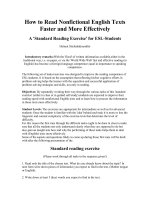how to read charts
Bạn đang xem bản rút gọn của tài liệu. Xem và tải ngay bản đầy đủ của tài liệu tại đây (156.55 KB, 10 trang )
How To Read Charts Like A Pro
Your guide to reading stock charts!
Courtesy of Swing-Trade-Stocks.com
You may distribute this book FREELY or use it as part of a commercial
package as long as this page and notices are left in place.
The content of this e-Book is not warranted for correctness, and is
used by the reader at his or her own will. No warranty is given for the
content of this e-Book.
Logos, graphics, company names and product names of the following
companies:
The registered trademarks and owned by the given companies which I
fully respect. They are used for illustrational purposes only.
Disclaimer:
The information contained within this website is for entertainment
only, and the authors hold no responsibility to the accuracy or
reliability of the information contained therein. Past performance, is
not indicative of future success. All trades involve risk, which includes
loss of all capital, and a professional advisor should be consulted prior
to any major financial decision.
1
How to Read Stock Charts
Introduction
Make no mistake about it. Reading charts is an art form that can be
mastered! There are many factors on a chart that go into making
trade decisions. You have to be able to analyze all of these factors
and come to a conclusion about whether or not to risk your hard
earned money on a trade. This is what separates the novice trader
from the professional.
There are several things on a chart that make it worthy of
trading. The questions that you want to ask yourself about the
chart are:
What stage is this stock in?
Is this stock in and uptrend or a downtrend?
Is the stock at the beginning, middle, or end of the trend?
How strong is the trend?
Where are the trend lines?
What wave is this stock in?
What do the moving averages tell me?
Was there a breakout recently?
Is the chart "smooth" or "sloppy"?
Are there any chart patterns?
Are there wide range candles in the direction of the trend?
Are there any gaps in the direction of the trend?
Are professionals selling strength or buying weakness?
Where are the support and resistance areas?
Is this stock at a Fibonacci level?
What does volume tell me?
2
I know it seems like a lot of information to try and keep track of but all
of the above questions are essential to chart reading mastery! Now,
print out that page of questions and keep it handy next to your
computer. Make several copies so that you can check off and make
notes as you analyze your next chart. Go ahead, I'll wait…
Got it printed out? Great! Now you won't forget anything important
when it's time to analyze a chart for your next trade. In the heat of
battle, when emotions are running high, it is very easy to forget to
look for some of the most basic things on a chart. I've done it. That
is, until I made this list!
Ok, now let's go through the list one by one to make sure that you
know how to answer the questions correctly. Don't worry, with
practice, you will not even need to think about these things.
It will become automatic.
You will be able to read charts with lightning fast speed.
In just a couple of seconds you will be able to glance at a chart and
know all the answers to the questions above.
Don’t believe me?
Just wait…
3
Stages, Trends, and Waves
Direction
Ok, let's looks at an example chart…
Nice chart! This stock broke out through a consolidation in July and
now it is in a nice strong trend. The green arrow is the day on which
we see this stock. So, what questions can we answer just from
glancing at this chart?
This stock is in stage two
You remember the stages right? Stage one is a consolidation, stage
two is an uptrend, stage three is another consolidation, and stage four
is a downtrend. This stock was in a stage one in July but at the end of
July, it broke out into a stage two. It is currently still in a stage two.
This stock is in an uptrend
This is the easy part. If a stock is heading toward the upper right
corner of a chart then it is in an uptrend! For some reason, this tends
to elude some traders.
This stock is near the middle or end of the trend
4
How do we know that? The breakout signals the start of the trend.
There has already been one significant pullback. Had we bought stock
on the first pullback, then we would have concluded that we are at the
beginning of the trend. But since this is the second pullback, then we
know that this trend may not last much longer.
This stock is in a strong trend
The ADX indicator (not shown) is near 30 which we consider to be a
fairly strong trend. The higher the ADX, the stronger the trend.
This stock is at the lower trend line
You can see by the thick green line that this stock has hit the lower
trend line. You can draw the trendlines in manually, but after you
have been trading for awhile, you will not need to draw them. You will
be able to see them automatically.
This stock is in the fourth wave
In Elliott Wave theory, a stock goes through 5 waves in an uptrend. In
the chart above, the first wave after the breakout is wave 1. The first
pullback is wave two, the next wave up to $69.00 is wave three, and
the pullback that we are in now is wave four. There is one more wave
to go!
Conclusion
Now we have identified that the possible future direction of this stock
is up. Nothing is ever certain in the stock market! However, by
looking at this chart we can be certain that the probabilities are on our
side for a continued move to the upside.
After you finish reading this book, go through some charts and try to
identify the various factors mentioned above. Just understanding the
nature of stocks and the different stages, trends and waves that all
stocks go through will greatly improve you trading.
Soon, all of this direction analysis will become second nature. You
won't even have to think about it.
Were not done yet! Go on to the next chapter…
5
Chart Analysis
Price
Price, as interpreted by candles, is the most important factor to
consider on a chart. Put away the technical indicators. You do not
need them. Technical indicators serve one purpose – to confuse
novice traders! There isn't anything on a chart that can be learned
from them. Everything you need to know is right in front of you in the
candles!
Ok, let's go back to our chart example:
There are some very significant things happening on this chart. Do
you see them? You will in a minute.
We continue answering questions…
The moving averages are lined up
We want the 10 SMA above the 30 EMA and we also want there to be
plenty of space in between the two moving averages. This creates the
Traders Action Zone (TAZ) that we can trade in. If the moving
averages move too close together, then a trading range or basing
pattern will likely develop. We don't want that!
There was a breakout recently.
6
This is good! We want to buy a pullback as close as possible to a
breakout as we can. Why? We want to know that there is interest in a
stock. Remember that institutional traders have to accumulate shares
over time. They can't buy tons of shares all at once. They have to
buy a little at a time. By looking for breakouts, we can expect them to
have to buy more in the future. This will propel the stock higher.
This is a smooth chart
We don't want to trade stocks that are whipping around everywhere!
That is a good way to get stopped out on trades. This stock is in a
smooth uptrend that can be traded with confidence, and without fear
of getting shaken out of the trade.
No significant chart patterns
In this example, there aren't any significant chart patterns. This is
fine. You don't need any kind of a chart pattern like a cup and handle
pattern, or a triangle to trade a stock. You do, however, want to be
able to identify them when they are there. This could add some
weight to the setup and may make us favor one trade over another.
There are wide range candles in the direction of the trend
See how at the end of August there are three wide range candles that
close near the top of their range? There was also a wide range candle
on the breakout in July. This is very significant! In fact it may be one
of the most significant things on the chart. Stocks tend to move in the
direction of wide range candles.
There is one significant gap
There is only one significant gap to the upside on the breakout in July.
Ideally, we would like to see more. A better case scenario would be if
there was a more recent gap. Why? Because stocks tend to move in
the direction of gaps! Be careful though. After three or more gaps, a
stock can become overbought and may not continue to move forward.
Professionals are buying weakness
How do we know this? We know by looking for "tails" or "shadows" at
the bottom of the candles. On the sixth of September there is a tail,
and on this day (green arrow) there is a tail. This is very significant!
You want to see that the big players are coming in to support the
stock. You want them to protect you from any downside risk.
7
This stock is at support
This stock has pulled back to a prior high made in the middle of
August. This is identified by the red/green support line drawn on the
chart. When a stock pulls back to a prior high it is known as minor
support. It is still a significant support area, just not as significant as
if it pulled back to a prior low. For example, if the stock pulled back to
the prior low at $63.00 (see chart), then it would be major support.
Also, notice how the lower trend line and the support line converge
into one right at today's candle (green arrow). This is very significant!
This increases the strength of the support.
This stock is at a Fibonacci retracement level
There are three fibonacci retracement levels that you look at: 38.2%,
50%, and 61.8%. This stock has pulled back to the 38.2% level (not
shown on the chart above). You want to trade pullbacks to this level
or the 50% level. If it goes down to the 61.8% level, it may be
signaling weakness. Avoid those stocks. Note that this level also
corresponds with the support line.
Volume is showing that there is interest in the stock
See the big volume on up days and the lower volume on down days?
This is the ideal scenario but it isn't absolutely necessary. I tend to
favor low volume pullbacks over high volume pullbacks but I will trade
both. If a stock is pulling back on low volume, it means that traders
have lost interest in the stock and things get really quiet. This is
usually when institutional traders come in – when everyone forgets
about the stock!
Conclusion
This concludes our analysis of the stock. We have determined that we
are going to trade this stock!
Want to see what happens next?
Go on to the next chapter…
8
Conclusion
Success!
Here is the finished chart:
Nice! All of our analysis has paid off. This stock has successfully
moved in our favor and now we can just trail our stops under the lows
of the candles until stopped out.
I know it seems like a lot of work went into analyzing this chart but
what can I say – trading stocks does take some work! It does,
however, get faster. After you look at thousands and thousands of
charts in this manner, everything will become second nature.
Instead of it taking minutes to look at a chart it will take seconds.
I hope you have enjoyed reading this little e-Book. More importantly,
I hope that you can use this information and profit from it! After all,
that is the goal – to make consistent profits in the stock market.
Please take the time to give me your feedback. You can send your
comments and suggestions on this page:
Trade Well,
Craig
9
Additional Resources
Websites
At swing-trade-stocks.com…
Market Stages
Stock Trends
Elliott Wave
Adx Indicator
Other sites…
Elliott Wave
For more information on wave theory visit Elliott Wave International.
There is no better site on the net for learning about elliott wave. You
can take the FREE tutorial on the trading the waves!
Trade Trakker
Need an inexpensive software solution to manage your trades? Try
out this program. I also have a review of this software on swing-
trade-stocks.com
InvestorFLIX
One of the best learning tools on the net! Get stock market DVDs and
CDs delivered right to your doorstep!
Site Build It!
Thinking about building your own website? This is the company that I
use
10









